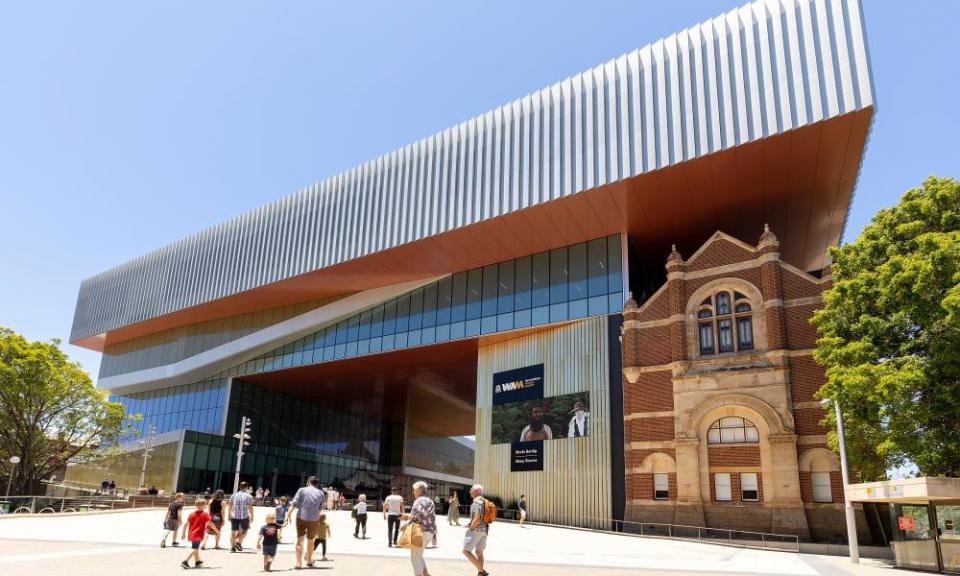WA Museum Boola Bardip denies changes to China display were due to political pressure

The state museum of Western Australia has changed a display that stated mainland China was the “origin” of the coronavirus and included Taiwan in a map of China, after a complaint from the WA Chinese consul general.
The WA Museum Boola Bardip said the exhibit was changed for “factual” reasons, not political pressure, because the World Health Organization has not yet determined where the virus technically originated.
Related: Australia cannot walk away from its free trade agreement with China, Labor says
The museum also changed a world map in the exhibit to include Taiwan when China was selected – claiming that it reflected “Australian government policy”.
But Mark Harrison, a senior lecturer in Chinese studies at the University of Tasmania, said this was “not correct” and the museum had overstepped Australia’s own foreign policy on Taiwan.
The change came after the museum received a letter of complaint from the WA Chinese consul general, Dong Zhi Hua.
A spokeswoman for the WA Museum said there was no coercion from the consulate and it was a factual correction.
“It has been suggested that the museum changed labels due to pressure from the Chinese consul general and changed our story in favour of China. This is simply not true.”
The previous exhibit described Covid-19 as “a coronavirus originating in mainland China”. While the outbreak originated in the Chinese city of Wuhan, the WHO has not yet confirmed where the Sars-CoV-2 virus itself originated.
The new text reads: “A coronavirus spreads across the globe.”
Related: UK and US lock in behind Australia in China row
Earlier, the chief executive of the WA Museum, Alec Coles, told Nine newspapers the museum would happily reinstate the line that China was the origin of the coronavirus once it was confirmed.
A museum spokeswoman added: “Whatever people’s personal views may be about international politics, as a museum we deal in facts. Suggestions that updates were made in response to coercion are without substance. The changes were made in the interests of factual accuracy.”
However, Harrison told Guardian Australia the inclusion of Taiwan as part of China was not actually reflective of “Australian government policy” as the museum claimed.
He said the Australian stance “uses a deliberate ambiguity on the status of Taiwan”.
“The museum is not correct to say that including Taiwan in the map of the People’s Republic of China is in accordance with Australia’s official position under Australia’s One China policy,” Harrison said.
“Australia’s One China policy uses a deliberate ambiguity on the status of Taiwan. Australia does not have diplomatic relations with Taiwan and recognises the PRC as the sole legitimate government of China but only goes so far as to acknowledge the position of the Chinese government that Taiwan is part of the PRC.
“The deliberate ambiguity of Australia’s One China policy makes the representation of Taiwan complicated in maps. The Australian government is very careful to not use maps of national boundaries that show Taiwan as part of the PRC.”
Researcher Sophie McNeill from Human Rights Watch Australia said the shift “fits a pattern” of political pressure from the Chinese government on museums and other institutions.
“We saw this in France, where two months ago Chinese officials tried to change and rewrite elements of an exhibition on Mongolian history and to blacklist certain words,” she told Guardian Australia.
“It’s very important that our cultural institutions rely on accuracy and facts and don’t bow to pressure from the Chinese Communist party, who are often trying to censor and rewrite history.”
Harrison added that Chinese propaganda focused on “normalising” the inclusion of Taiwan as a part of China.
“The PRC has worked very hard in Australia to conflate Australia’s One China policy with Beijing’s One China principle,” he said. “They are not the same, and a lot of what has been described as United Front work or political interference in Australia has been focused on normalising Beijing’s One China principle in levels of government and public institutions. This is an example of those efforts.”
Despite the Chinese Communist party never having ruled Taiwan, the Chinese government considers it to be a breakaway province of the People’s Republic of China.
Earlier this week, before the museum’s announcement, Taiwan’s foreign minister, Joseph Wu, had told Guardian Australia that China was pressuring other governments to accept its One China principle, which claims Taiwan as a province.
“China has been changing the nomenclature of international businesses in describing Taiwan [to say] not ‘Taiwan’ but ‘Taiwan province of China’, or ‘Taiwan, China’,” Wu said.
“But of course that’s not the reality of the situation in Taiwan. You come to Taiwan, you don’t go through the Chinese government to get access to Taiwan.”

 Yahoo News
Yahoo News 